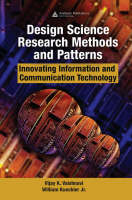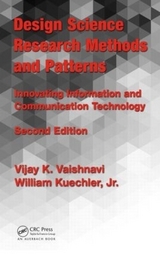
Design Science Research Methods and Patterns
Auerbach (Verlag)
978-1-4200-5932-8 (ISBN)
- Titel erscheint in neuer Auflage
- Artikel merken
Design research promotes understanding of advanced, cutting-edge information systems through the construction and evaluation of these systems and their components. Since this method of research can produce rigorous, meaningful results in the absence of a strong theory base, it excels in investigating new and even speculative technologies, offering the potential to advance accepted practice.
Design Science Research Methods and Patterns presents innovative research methods that help break new ground by applying patterns, reuse, and design science to research. The book relies on familiar patterns to provide the solid fundamentals of various research philosophies and techniques as touchstones that demonstrate how to innovate research methods. Filled with practical examples of applying patterns to IT research with an emphasis on reusing research activities to save time and money, this book describes design science research in relation to other information systems research paradigms such as positivist and interpretivist research.
Georgia State University, Atlanta, USA University of Nevada, Reno, USA
INTRODUCTION
DESIGN SCIENCE RESEARCH METHODOLOGY
Introduction to Design Science Research in Information and
Communication Technology
Overview of Design Science Research
Research
Design
Can Design Be Research?
The Outputs of Design Science Research
An Example of Community-Determined Outputs
The Philosophical Grounding of Design Science Research
Design Science Research Methodology (By Example)
An Example of ICT Design Science Research
Smart Objects: A Design Science Research Project
Awareness of Problem
Suggestion
Awareness of Problem Redoux
Development
Evaluation
Conclusion
Epilogue
Design Science Research versus Design
References
General References on Design Science Research
References on Philosophical Grounding of Design Science Research
References on Design Science Research Methodology
References on Understanding Design Science Research in the
Context of Information Systems Research
The Aggregate General Design Cycle as a Perspective on the Evolution of Computing Communities of Interest
Introduction
The General Design Cycle
The Aggregate General Design Cycle
Exercising the AGDC Framework:Concept Mapping 25 Years of
Database Research
Using the AGDC to Explain Coordination between Diverse Groups
Conclusion
References
A Process to Reuse Experiences via Written Narratives among Software Project Managers: A Design Science Research Proposal
Research Problem
Research Questions
Research Motivation
Research Approach
Research Methodology
Awareness of Problem
Suggestion
Development
Evaluation
Summary
Limitations and Expected Contributions
References
PATTERNS
[The prefix M indicates that the pattern is a meta-level pattern, applicable to multiple
stages in the research process. Meta-level patterns are explained in more detail at
the end of Section 5.3.]
Using Patterns to Illuminate Research Practice
Introduction
Patterns, Then and Now
The General Design Cycle Revisited
Pattern Usage in the Development of the Smart Object Paradigm
Pre-Awareness of Problem
Awareness of Problem
Suggestion
Development
Evaluation
Conclusion
Practice, Practice, Practice
References
Creativity Patterns
Creativity
MStages of Inventive Process
MWild Combinations
MBrain Storming
MStimulating Creativity (Ladd, 1987)
Problem Selection and Development Patterns
Problem Selection and Development
Research Domain Identification
Problem Area Identification
Problem Formulation
MResearch Conversation
Leveraging Expertise
MCost-Benefit Analysis
MSolution-Scope Mismatch
MBeing Visionary
Research Offshoots
Bridging Research Communities
Experimentation and Exploration
Hierarchical Decomposition
Interdisciplinary Problem Extrapolation
MQuestioning Constraints
Structuring an Ill-Structured Problem
MAbstraction
MComplex System Analysis
Literature Search Patterns
Literature Search
Familiarization with New Area
MUnderstanding Research Community
Framework Development
MIndustry and Practice Awareness
Suggestion and Development Patterns
Suggestion and Development
Theory Development
Approaches for Building Theory
Hermeneutical and Inductive Approach
Incremental Theory Development
MProblem Space Tools and Techniques
MResearch Community Tools and Techniques
Empirical Refinement
Easy Solution First
Elegant Design
Divide and Conquer with Balancing
Hierarchical Design
Building Blocks
MSketching Solution
Emerging Tasks
Modeling Existing Solutions
Combining Partial Solutions
Static and Dynamic Parts
Simulation and Exploration
MInterdisciplinary Solution Extrapolation
MDifferent Perspectives
General Solution Principle
Abstracting Concepts
Using Surrogates
Using Human Roles
Integrating Techniques
MTechnological Approach Exemplars
MMeans-Ends Analysis
Evaluation and Validation Patterns
Evaluation and Validation
Demonstration
Experimentation
Simulation
Using Metrics
Benchmarking
Logical Reasoning
Mathematical Proofs
Publishing Patterns
Publishing
Conference and Journal Submissions
Writing Conference Papers
Writing Journal Papers
MStyle Exemplars
MAligning with a Paradigm
Novelty and Significance
Use of Examples
RESEARCH PATTERN USAGE EXEMPLARS
Pattern Analysis of Design Science Research Exemplars
Pattern Analysis
"A Data/Knowledge Paradigm for the Modeling and Design of
Operations Support Systems"
"Automating the Discovery of As-Is Business Process Models:
Probabilistic and Algorithmic Approaches"
"Improving Analysis Pattern Reuse in Conceptual Design:
Augmenting Automated Processes with Supervised Learning"
"A Case-Based Database Design Support System"
"World Wide Web: Proposal for Hypertext Project"
"The Entity-Relationship Model: Toward a Unified View of Data"
"A Relational Model of Data for Large Shared Data Banks"
"The Working Set Model for Program Behavior"
"Communicating Sequential Processes"
"Optimum Multiway Search Trees"
| Erscheint lt. Verlag | 7.11.2007 |
|---|---|
| Zusatzinfo | 3 Halftones, black and white; 10 Tables, black and white; 14 Illustrations, black and white |
| Verlagsort | London |
| Sprache | englisch |
| Maße | 156 x 234 mm |
| Gewicht | 499 g |
| Themenwelt | Mathematik / Informatik ► Informatik ► Theorie / Studium |
| ISBN-10 | 1-4200-5932-7 / 1420059327 |
| ISBN-13 | 978-1-4200-5932-8 / 9781420059328 |
| Zustand | Neuware |
| Haben Sie eine Frage zum Produkt? |
aus dem Bereich



